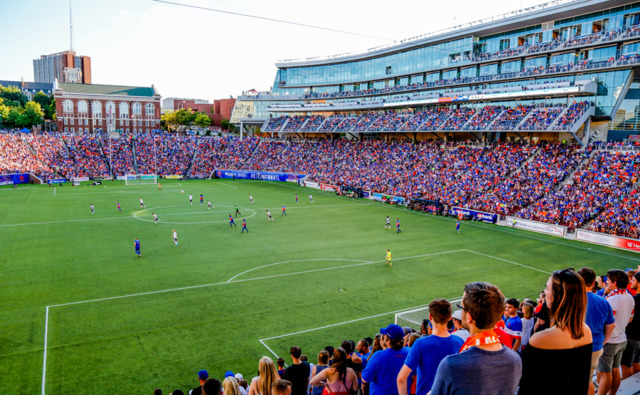
FC Cincinnati announced at a news conference yesterday it will pay for the entirety of a $200 million, 21,000-seat soccer stadium it says it needs to win a bid for a Major League Soccer franchise. But that’s not everything, and there are still a whole lot of questions.
The team is asking the city of Cincinnati and Hamilton County to throw down $75 million for infrastructure improvements at the site — most likely Oakley — where it will build the stadium.
That’s better than the team’s initial ask of $100 million in public funds to build the stadium, but still a sizeable amount of money. The money, as laid out by FC, would come from the county’s visitor occupancy tax, which hotel guests pay when they stay in a Hamilton County hotel. There’s a $2.8 million-a-year pool of that money set aside for “other projects” going to the city and county that FC would like to tap. That, and other as-yet-unspecified city sources, would pay for the infrastructure. But the county controls the purse strings.
Commissioners have in the recent past mentioned the fund to pay for other county needs, and have suggested the team possibly use Paul Brown Stadium. But FC says that the venue won’t work and it needs a dedicated soccer facility.
FC’s ask includes a 1,000-car parking garage, road improvements and other investments. That’s down from a 4,000-car garage the team originally envisioned. It’s also reduced the size of the stadium from 25,000 seats to save funds.
The soccer team will also cover the $150 million cost of the MLS franchise, team leaders say. Bids for one of four expansion licenses are due next month. FC General Manager Jeff Berding says Mayor John Cranley is on board with the team's plan, but that he still hasn’t secured the agreement from Hamilton County Commissioners. They’re set to hold a 1 p.m. news conference today to discuss FC’s proposal.
“At this point, it doesn’t appear like we have county support to use this ‘other projects’ funds to support the infrastructure needs of this project,” Berding said at yesterday's news conference. “At this point, it is rather unclear whether the county shares the vision.”
Berding and Carl Lindner III, head of the team’s ownership group, put the pressure on county commissioners, calling the deal a “layup” and repeatedly praising Cranley’s “extraordinary” leadership in agreeing to their plan and coming up with the idea of using the hotel tax funds. Berding says that should FC be able to lock down a stadium plan, its bid to join the MLS would be "ours to lose." The team consistently outdraws others already in the league even though it's in a second-tier league. But without the dedicated stadium — an MLS requirement for teams applying to join the league — its chances are dim.
“This is the last box to be checked, so we’re really hoping our county commissioners recognize what a great legacy opportunity it is to have FC Cincinnati move up to MLS,” Lindner said.
Beyond the county, there could be other hurdles: Cincinnati City Council will need to approve any city spending on the infrastructure. It’s unclear if council members will back the plan.
“We’ve had real good conversations with council members and those conversations continue,” Berding said.
Other cities, including Charlotte, N.C. and St. Louis, have seen their teams’ MLS bids likely killed due to inability to lock down funding for stadiums. St. Louis voters rejected a plan to pitch in $60 million for a stadium back in the spring, and Charlotte officials couldn’t come to an agreement about how much money to kick in for their team’s stadium project. Commentators in St. Louis have questioned the idea that the stadium would bring much economic development or benefit to taxpayers.
In other places, including San Diego, Tampa, Phoenix and Detroit, taxpayers wouldn’t have to pay much, if anything, to fund a soccer stadium or renovations to an existing stadium for MLS aspirants. In Nashville, taxpayers will front the money for the city’s $275 million stadium to support their team’s bid, but will reap the money back in taxes raised by ticket and other sales taxes associated with the team.





